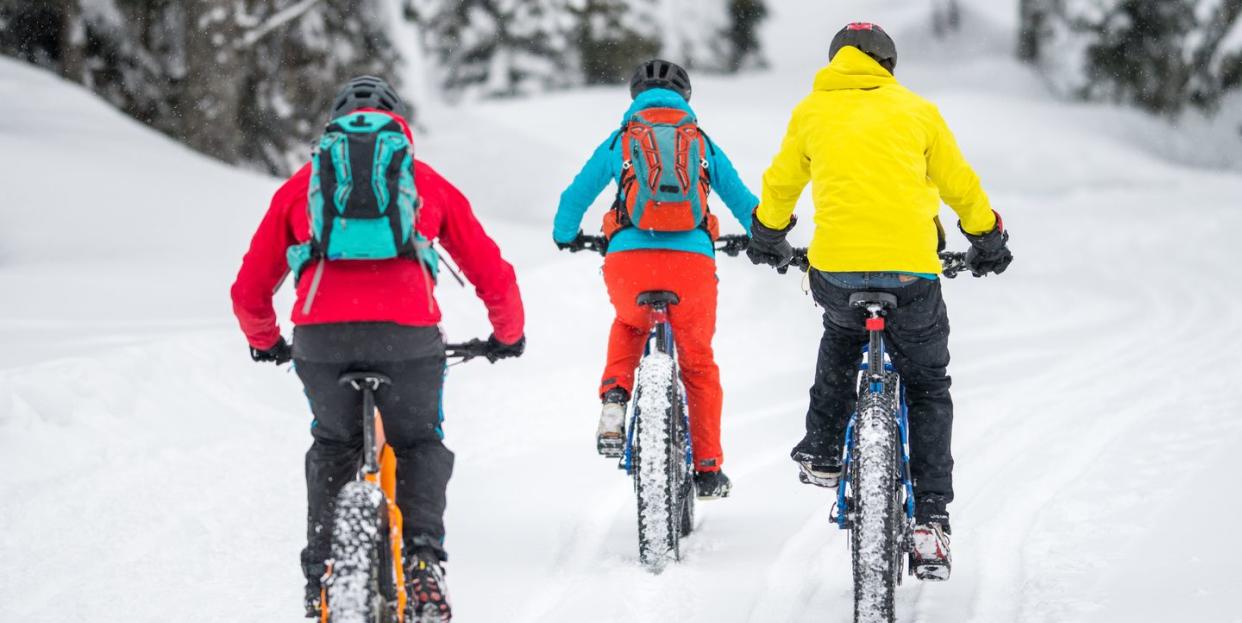11 Things That Happen When You Ride in the Cold

You’ve made the commitment to tough it out and keep riding right through the winter this year. It won’t be easy, but it’s safe to say that you can expect a lot from your efforts. So prep your bike and break out your warmest gear, because here are eleven things that happen when you fully embrace winter cycling.
You get stronger.
Winter is classic base-training time. Riding long, steady sessions in Zone 2 (around 70-percent max heart rate) for several weeks over the winter increases the size and number of your energy-producing mitochondria, helping you ride longer and eventually faster in your aerobic range before hitting threshold. A surprise bonus: Because you’re wearing heavier clothes, carrying more gear, and often using a heavier bike (like a cyclocross bike, mountain bike, or fat bike), you’re also getting stronger and building muscular endurance in the process.
You get smugger.
You’ll find yourself humble bragging all over the place about how you’re braving the elements while others forsake their winter fitness. Don’t feel bad: All those cold outside rides will also make you legitimately tougher in the face of bad weather. When it’s a little chilly and rainy come spring, you’ll be totally comfortable while your still-hibernating buddies shiver in their gaiters.
You incinerate calories on and off the bike.
When the temperatures fall, your metabolism rises to keep you warm and you burn more calories. However, studies suggest that the cold-induced calorie-burn boost washes out after you warm up and start exercising. That’s likely true when you’re running or doing full-body workouts, but that winter warm up effect is less pronounced out on the open road where your upper body is exposed and relatively quiet. So you’re always going to be a little chillier, which brings us to another bonus: nonshivering thermogenesis (NST). While being cold enough to shiver raises your metabolism fivefold, shivering is terrible, and nobody wants to do it while they ride. But being just mildly chilly triggers NST, which not only bumps up your calorie burn on the bike, but also makes your fat more metabolically active even when you’re not riding, so you may burn more calories at rest, too.
You look at cycling in a new light.
Ice, snow, and bitter cold can keep you off your usual wide-open road routes, and that’s okay. You’ve spent plenty of time on them and will again. The beauty of winter riding is it forces a bit of creativity. You may find yourself riding circuits through an industrial park, clover leafing around the outskirts of your neighborhood, or riding towpaths or rail trails that are too busy to enjoy during peak season, but are blissfully abandoned during the winter months—and loving every minute.
[Find 52 weeks of tips and motivation, with space to fill in your mileage and favorite routes, with the Bicycling Training Journal.]
You find peace and solitude.
That part we just mentioned about the abandoned paths and trails? There’s a special beauty in not having to ring your bell, call “on your left,” or worry about a ton of traffic. You’ll find that you have a front row seat to Mother Nature’s most beautiful displays of glistening ice-encrusted trees, misty cornfields, and pastel morning light on freshly fallen snow. Maybe not surprisingly, research shows you’re also less likely to succumb to the winter blues or Seasonal Affective Disorder (SAD) when you regularly exercise outdoors.
You become a master layerer.
Cycling in the cold is both an art and a science. Riding through the winter makes you a Jedi Master at covering your core, extremities, and phalanges in winter layers that are just right for 35 degrees with low humidity and sunshine, as well as 24 degrees with heavy clouds and high humidity.
You learn what “re-entry” feels like.
Even Jedis miss the mark sometimes. Despite your best intentions, you’ll find yourself 17 miles from home with aching toes, numb hands, frozen water bottles, and a world of hurt. As you’ll learn, that frozen, numb part isn’t so bad. The searing pain, deep aching, and maddening itching you feel when those frozen bits thaw out into the land of the living? Now that’s bad.
You’ll wear through bike gear.
Old Man Winter is an SOB. He’ll chew through your tires and—if you’re not careful—wreak havoc on your drivetrain, brakes, and cables. Proper winter bike care can help protect your bike components, but you’ll probably still need new tires come spring.
You’ll be ready to sprint into spring.
When you ride all winter long, you are bananas for the spring. Once you shed your baselayer, midlayer, jacket, booties, arm warmers, winter gloves, and 28mm tires, you will be so ready to rage!
You’ll burn some matches.
Approach winter training with care. Yes, it’s true that you can maintain, even build, valuable fitness. However, nobody can be on form year-round. If you ride too hard over the winter, you run the risk of coming into February flying but feeling burned out by July. Meter out your winter training to leave you excited to race come spring, but not feeling like you could win your whole series by Groundhog Day.
You’ll need fewer sick days.
Research shows that regular exercisers are about half as likely to get sick as their couch-loving peers. You also earn bonus health points for being out on your bike and away from indoor environs that get so germ-infested this time of year.
You Might Also Like